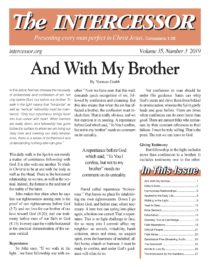
Editor’s Note
The Bible is timeless. God designed it to be as applicable today as it was when it was written. Looking to the New Testament we find that the Apostle Paul’s letters to the early churches provide us a guidebook for right and successful Christian living even today. He talks about how to fellowship with one another—encouraging one another and showing brotherly kindness. He also addresses church discipline—how we should exhort and admonish one another, and how we should deal with members who are in sin. Paul not only instructs Christians on what they should do, but also shares with us the answer for how to victoriously carry it out…“the mystery which has been hidden from ages…Christ in you” (Colossians 1: 26, 27). In this issue of The Intercessor we are pleased to expound on many of these same important topics. Norman Grubb and others share much insight into right living, as always, in the context of there being no human self who can operate independently of either the spirit of Christ or Satan.
Our lead article, “And With My Brother,” is an excerpt from Norman Grubb’s pamphlet, Continuous Revival. It gives biblically guided instruction for how to have right relationships, not only with God, but with our fellow man. As Norman says, “roof off” (no barrier between us and God) / “walls down” (no barrier between us and our brother). Our responsibility is in confession and open fellowship.
Following along from reading how we are to be towards our brother, we then have an article aimed at how to “see” our brothers as Christ sees them. Titled “Difficult People,” it explains how God means us to view another believer whom we don’t get along with, or who “rubs us the wrong way.” It gives a sound reminder on the danger of seeing any fellow believer as separate from Christ.
And since how we handle relationships is of such vital importance, we’ve added another piece that is in the same vein. This next excerpt from Norman Grubb’s The Law of Faith, titled “Harmonious Relationships,” advises us on how to rightly handle problematic people in our lives. Through being faithful and obedient to get God’s view about yourself and the other person, and having faith and trust in Christ’s life in you, you can have inner victory and liberation in these difficult situations.
Additionally, for a personal illustration of God’s glory being revealed in a difficult relationship, turn to “Walking in the Light.” It provides a testimony from missionary Edith Moules, who made the decision to see herself and the other person the way that God saw them—even though she didn’t feel like doing so. Victory was hers in the end!
Another example from the early church, along the lines of church discipline, is exhortation. Exhortation is defined as “emphatically urging someone to do something.” The New Testament describes it as being both daily and mutual among church members. In this reprinted chapter from Continuous Revival, emphasis is put on the importance and responsibility we have in exhorting one another. While many churchgoers in today’s world might call such confrontations “unkind,” in truth it is godly concern for the brother in question. And as Norman says,“When a brother is not on top spiritually, it hinders the working of [Christ’s] Spirit; therefore it is part of our duty to Him to be faithful to the brother. Not to be so is sin.”
Next, “Trust and Obey” is a fresh testimony that we hope many will be able to identify with, as well as derive inspiration from. It is a clear example of one who has faced both the first and second spiritual crises in her life—the first crisis being the need for salvation; the second being the revelation that the Christian life can only be successful when we recognize that Christ’s Spirit is actually joined to ours in order to live out His victorious life through us.
“Standing True at Cambridge” tells the story of how Norman Grubb’s faith and obedience to share the uncompromising gospel of Christ on his campus led to the establishment of the InterVarsity Fellowship on campuses around the globe—an act that would transform the lives of many.
Also featured is the third and final part to “Faith Illustrations: the Joseph story”—picking up with Joseph’s brothers’ return to Egypt and the restitution and forgiveness that follows. The feature “Applied to the Daily Life” advises us to see our trials as God’s way for us to meet the needs of others, and towards the back of the magazine don’t miss our featured Bible verse which gives us a glimpse into what was expected from members in the first church.
Thank you for reading and supporting The Intercessor and helping us spread the wonderful truth of Christ joined to us in spirit—He living through and as us! We hope we’ve provided you with helpful examples of how we should live in fellowship with each other like those of the early church.





